2018 - 2019
PLASTER HEADS


Freddy Van gaever
Freddy Van Gaever was a businessman from Antwerp. In 1963 he founded the transport company Freddytrans. By the end of the decade, thanks to the growth of the Port of Antwerp, Freddytrans, which had started with only two trucks, counted more than thirty in its service. In the early 1970's Van Gaever launched himself into aviation. He bought two old planes and managed four daily freight flights from Deurne (near Antwerp) to Amsterdam, a journey of 200 kilometres. The company was called FreddyAirTrans, or FAT. It was a childhood dream come true. But not a long-lasting one. The airline was far from profitable and FAT, after just a few months, was overtaken by SABENA, the national airline of Belgium. Van Gaever was resentful of the national politics and became an ardent supporter of the Flemish militant movement. In addition to the militant movement, Van Gaever embarked on a new project: the VLM, a Flemish aviation company. The VLM operated flights from Deurne to London City and Basel in the 80's and 90’s, mainly serving the Jewish community of diamond dealers whose headquarters were in Antwerp. The fact that the clientele of the VLM was mainly Jewish and that Van Gaever was affiliated with the militant Flemish movement (Nazi collaborators during WWII) never posed a problem. Freddy Van Gaever mastered the art of negotiation. For some years the VLM had reasonable success, but the growing competition in the aviation market weakened the company. In recent years, Freddy once again tried his chances in aviation. He purchased a large aircraft from a bankrupt company and had his name painted on it. V.G. Airlines. The flight went from Brussels to New York. It flew once. There were no passengers on board. Only Freddy Van Gaever. Shortly after he died.
2018
Plaster, Paint, Mixed Media
43x20.5x20.5CM
CONTACT
Gallery Micheline Szwajcer - Antwerp
contact@gms.be
+32 3 237 11 27


Krikke & Trikke De Loos
Antwerp's nightlife has never known bouncers as good as Krikke & Trikke De Loos. During the mid and late 1980’s these identical twins managed the monopoly of security guards for mega dancehalls in and around Antwerp. Thanks to their bold approach and excellent interpersonal skills, Krikke & Trikke always succeed in protecting the nightlife from suspicious individuals. They developed the STAFNA protocol for outdoor bouncers. STAFNA, which stands for See, Talk, Ask, Feel, Negotiate, Attack, was an efficient method to recognize and deal with critical club clients by firmly and quickly removing them from the group. The first step was to visually select the "Target" followed by a brief conversation to understand his intentions, then, a body search. If the result was positive, a quiet departure from the club would be negotiated with the individual. If the subject reacted negatively the bouncer would switch into attack mode and use physical violence to distance him. Violent movies from Bangkok that a friend would procure on a regular basis were Krikke & Trikke's inspiration for the STAFNA system. Thanks to the efficiency of the STAFNA method, nightclub owners experienced a rapid increase in sales and a decrease in the number of incidents involving the security forces. On October 17, 1993 Krikke & Trikke's heavily severed bodies were found in a ditch along the E19 motorway towards the Netherlands. It is probable that they were the victims of drug criminals from Rotterdam who saw their sales fall because of the STAFNA system. The culprits were never found and the investigation was abandoned in 2013, twenty years after the fact. The brothers were buried in the cemetery of Merksem where they grew up. More than seven hundred people attended the memorial service, including the Mayor of Antwerp.
2018
Plaster, Paint, Mixed media
43,5x41x20,5CM
SOLD


ALEXANDER LUKASHENKO
Alexander Grigoryevich Lukashenko is one of the most famous politicians in modern Belarus.
In the past he did not belong to the Communist Party or any government nomenclature, nor did he hold any posts within the power hierarchy.
In 1995, Lukashenko was accused of making a remark that was construed to be in praise of Adolf Hitler: "The history of Germany is a copy of the history of Belarus. Germany was raised from ruins thanks to firm authority, and not everything connected with that well-known figure of Hitler was bad. German order evolved over the centuries and attained its peak under Hitler.”
Lukashenko believes that the president should be a conservative person and avoid using modern electronic gadgets such as an iPad or iPhone. He used to play bayan and football, but abandoned both during his presidency. He is a keen skier and ice hockey forward, who played exhibition games alongside international hockey stars. His two elder sons also play hockey, sometimes alongside their father. Lukashenko started training in cross-country as a child, and in the 2000s competed at the national level.
2018
Plaster, Paint, Mixed media
43,5x20,5x20,5CM
CONTACT
Gallery Micheline Szwajcer - Antwerp
contact@gms.be
+32 3 237 11 27
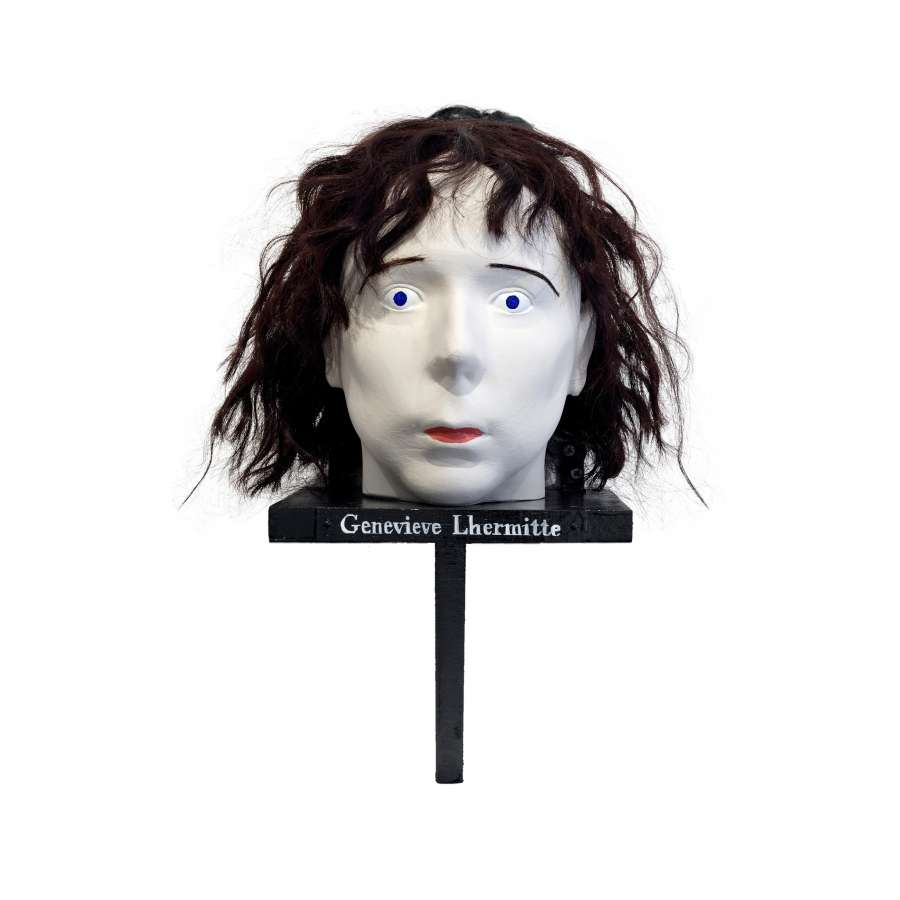

Genevieve Lhermitte
On the 28 of February 2007 Genevieve Lhermitte murdered her five children. Depression and psychological problems drove her to commit this atrocity. Lhermitte believed her family was terrorized by Doctor Schaar (meaning ‘scissors’), a GP who lived with the family. Doctor Schaar always denied these accusations and claimed his sole intent was to assist the family financially. He was also the godfather of one of the children. Lhermitte's husband, who would often stay abroad, spent more and more time away from family life. In a fit of insanity Genevieve Lhermitte took her children one by one as they sat watching the movie Spy Kids 3 and killed them. She was sentenced to life imprisonment.
2018
Plaster, Paint, Mixed media
43,5x20,5x20,5CM
CONTACT
Gallery Micheline Szwajcer - Antwerp
contact@gms.be
+32 3 237 11 27


Rudes
Rudes was originally named Rudy De Smet but, as he discovered his talents as a singer and writer, he became a singer song writer and changed his name to Rudes. Which means nothing. People say he was born in a community centre and raised via Microsoft Excell. His most famous song is called 'Women bite differently than in the past'.
2017
Plaster, Paint, Mixed media
20x15x15CM
SOLD
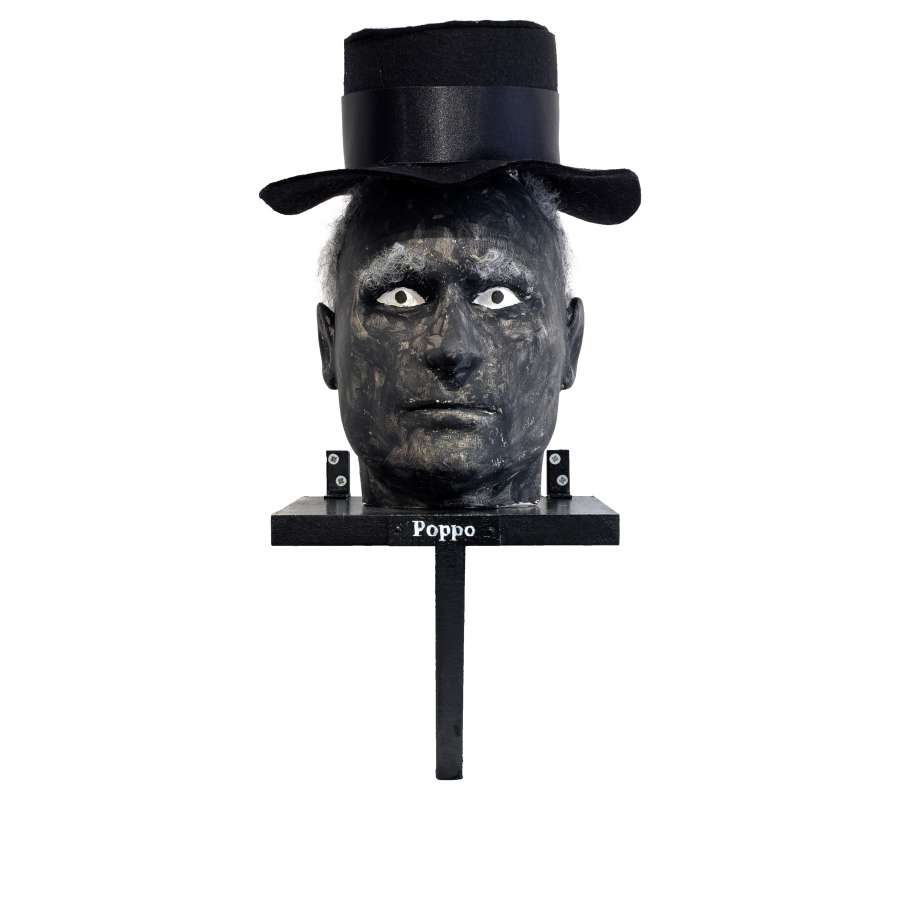

POPPO
Poppo is the living embodiment of the industrial age.
For years, he worked as a chimney sweeper and as a steam train technician.When diesel made its entry in the market Poppo smoothly adapted to it and became a specialist of diesel locomotives. Similarly, he later became a pro of electric railways. He was the man effortlessly connecting high-voltage cables through which millions of volts flowed. He got electrocuted several times but, after short medical check ups, he would quickly get back to work. Since the advent of green electricity Popo is inactive. He does not believe in climate change and thinks back with nostalgia at the time of fossil fuels. His black face is a trace of the time when his first love dominated the world: coal. Occasionally, he is spotted walking on the heaps of the closed coal mines around Charleroi. He rolls thick cigarettes and stares into the distance.
2018
Plaster, Paint, Mixed media
55x25x20,5CM
SOLD


GRINGO
Gringo is a cheesy guy from the West of Barcelona. He knows how to please everyone with jokes, pranks and crazy dance parties. In the summer Gringo loves to hang out in the Ramblas entertaining young tourists. A selfie with Gringo is priceless, and thanks to social networks, his name is known to the whole world. Gringo calls himself an internet phenomenon. He is a welcome guest at the clubs of Ibiza where famous DJ's enthusiastically announce him to ignite the crowd. With the arrival of the calmer autumn months Gringo retires to his cottage in Navarra. There he fills his days with his favorite hobby: driving around on a quad. Together with his friends he goes for risky tours of the desert landscape. Last year, one of his friends had an accident and remained paralyzed for the rest of his life. Gringo blamed his friend for his recklessness and never visited him in the hospital. He sent him a selfie from Phuket in Thailand, where he moves to in the winter to avoid the desolate and grey weather. In the selfie Gringo is amongst a group of young people who are waving their arms up in the air, delirious with joy because Gringo is with them.
2018
Plaster, Paint, Mixed media
43,5x20,5x20,5CM
CONTACT
Gallery Micheline Szwajcer - Antwerp
contact@gms.be
+32 3 237 11 27
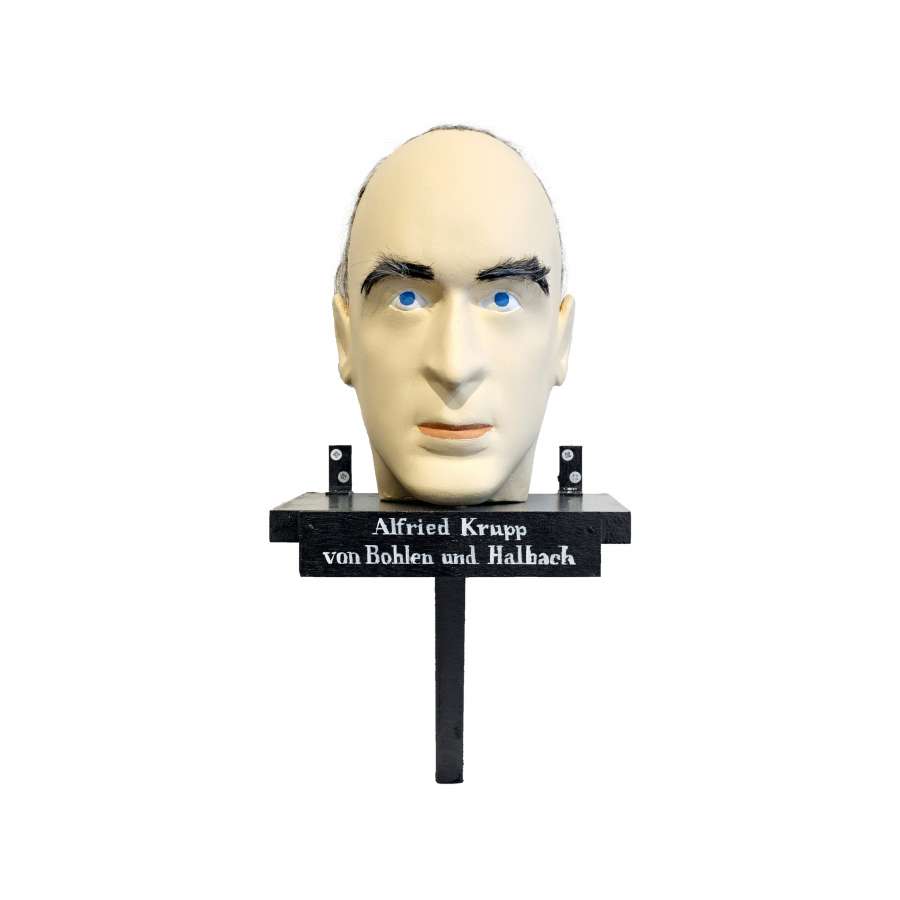

Alfried Krupp
von Bohlen und Halbach
Alfried Felix Alwyn Krupp von Bohlen und Halbach, often referred to as Alfried Krupp, was an industrialist, a competitor in Olympic yacht races, and a member of the Krupp family, which has been prominent in German industry since the early 19th century. He was convicted after World War II of crimes against humanity for the way he operated his factories. He served three years in prison, and was pardoned. The family company, known formally as Friedrich Krupp AG Hoesch-Krupp, was a key supplier of weapons and materials to both the Nazi regime and the Wehrmacht during World War II. In 1943, Krupp became sole proprietor of the company, following the Lex Krupp ("Krupp Law") decreed by Adolf Hitler. Krupp's wartime employment of slave labor resulted in the "Krupp Trial" of 1947–1948, for which he served three years in prison. After his death, his son Arndt waived his inheritance. However, he agreed to receiving a yearly allowance of 2 million DM which allowed him to fly constantly between Miami and Marrakesh. His son Arndt died of an overdose at the age of 48.
2018
Plaster, Paint, Mixed media
43,5x20,5x20,5CM
CONTACT
Gallery Micheline Szwajcer - Antwerp
contact@gms.be
+32 3 237 11 27
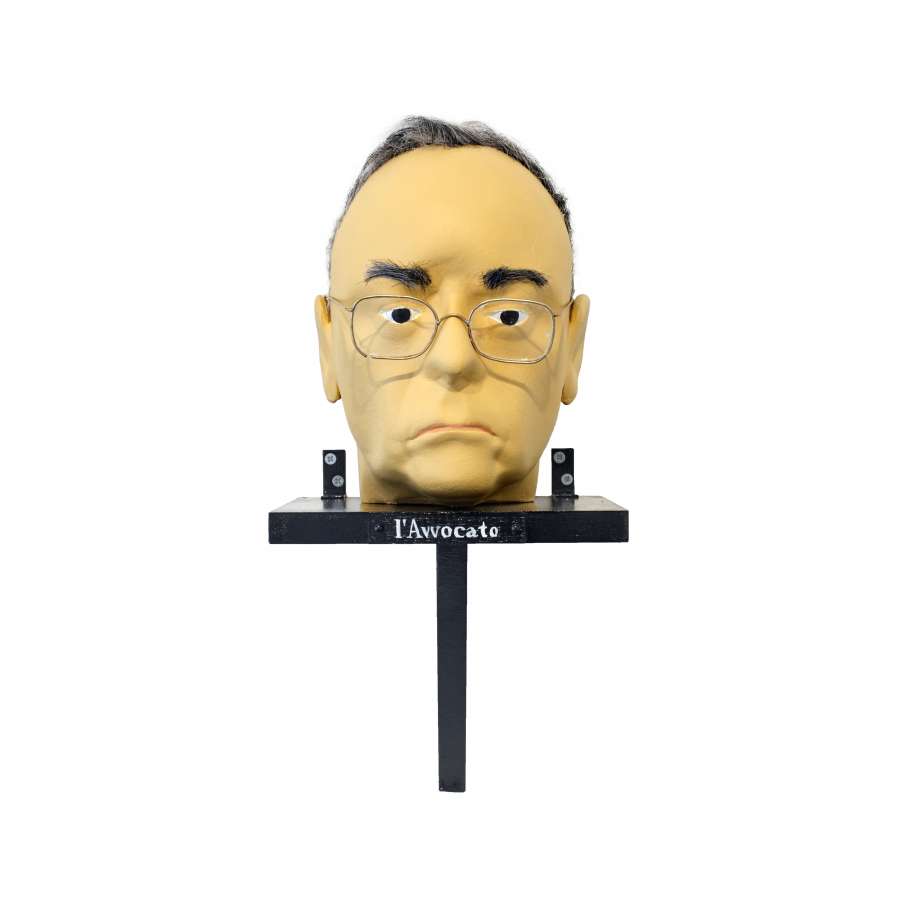

L'AVVOCATO
Born in Calabria, l'Avvocato grew up in Rome, where he worked as a lawyer. In 1971 he became acquainted with Silvio Berlusconi, the construction magnate and media mogul who later became Italy's Prime Minister. In 1972 l'Avvocato became the sole guardian of a nineteen year old girl whose father, the Marquis Casati Stampa, had committed suicide after murdering his wife and her lover. A few years later this infamous incident, l'Avvocato convinced the orphan girl to sell her villa in Arcore to Berlusconi for 500 million lire, a third of the property's actual value. The sum was paid in form of shares of companies belonging to Berlusconi. L'Avvocato always stood by the side of Berlusconi earning the reputation of a ruthless, but extremely capable lawyer. He owns a beautiful house on the coast of Tuscany, from where he can see the Island of Montecristo, a small island that is only inhabitated by black rats. A human being wouldn't last long on Montecristo.
2018
Plaster, Paint, Mixed media
43,5x20,5x20,5CM
CONTACT
Gallery Micheline Szwajcer - Antwerp
contact@gms.be
+32 3 237 11 27


Guido de Belder
De Belder Guido grew up in Tienen. His mother was a pianist during the silent movie era. From an early age he would go to the cinema and dream of one day working in 'the factory’, meaning Hollywood. In the 1980's, De Belder played 'the bad guy' in some German and Belgian productions, including a few films by De Gruyter & Thys. After getting divorced, he went to live with his mother in a social housing building in Leuven. De Belder was also a talented singer.
2017
Plaster, Paint, Mixed media
20x15x15CM
CONTACT
Gallery Micheline Szwajcer - Antwerp
contact@gms.be
+32 3 237 11 27


ABDOU LE FOU
Abdou le Fou (Abdou the Fool) earned his nickname at an early age thanks to his psychopathic and unpredictable character. He could stare at people so long that they would literally pee their pants. Rumour has it he was able to set objects on fire just by looking at them. He hardly ever spoke, but when he did he would whisper. He suddenly disappeared from the earth. Though some swear they saw his headless body walking around at the university campus of Leuven...
2017
Plaster, Paint, Mixed media
20x15x15CM
CONTACT
Gallery Micheline Szwajcer - Antwerp
contact@gms.be
+32 3 237 11 27


Idi Amin Dada
He was referred to as: His Excellency, President for Life, Field Marshal Al Hadji Doctor Idi Amin Dada, VC, DSO, MC, Lord of All the Beasts of the Earth and Fishes of the Seas and Conqueror of the British Empire in Africa in General and Uganda in Particular. Amin was born around 1925 in Koboko County in the West Nile district, home of the Kakwa tribe. His father had spent much of his life in southern Sudan where the Kakwas, an Islamic people, had originated. His mother was from the ethnically related Lugbara tribe. Early Victorian explorers observed violence and bloodletting to be particularly marked among these Sudanic-Nubian peoples; the homicide rate of the region is still one of the highest in Africa to this day. The death toll during the Amin regime will never accurately be known. The best estimate put the number killed at 500,000. Amin's downfall came in 1979. He was briefly exiled in Tripoli before moving to Saudi Arabia where he was given a villa in Jeddah. From that moment on he gave no interviews and stayed close to home. His life appears to have been a dull routine of sports events, gym sessions, and massage parlours. He had a Range Rover, a Chevrolet Caprice, and a powder-blue Cadillac that were used for shopping trips and visits to the airport, in order to clear the parcels of cassava and other food items sent by relatives in Uganda through customs. Some quotes of Idi Amin Dada: “I have to keep law and order and it means that I have to kill my enemies before they kill me.” “If we knew the meaning to everything that is happening to us, then there would be no meaning.” “I propose getting rid of conventional armaments and replacing them with reasonably priced hydrogen bombs that will be distributed equally throughout the world.
2018
Plaster, Paint, Mixed media
43,5x20,5x20,5CM
CONTACT
Gallery Micheline Szwajcer - Antwerp
contact@gms.be
+32 3 237 11 27


Kate Webster
Irish woman Kate Webster carried out one of the most notorious and savage murders of 19th Century England when she killed and dismembered her employer, Julia Martha Thomas. Born Catherine Lawler in Killanne near Enniscorthy, Co. Wexford in 1849, young Kate gained a reputation for theft from an early age, no doubt causing shame for her poor but respectable parents. She was imprisoned for larceny in Wexford at the age of 15. After her release, she continued to steal until she raised enough money for a ticket to Liverpool in 1867. At some point she took the name Webster (one of many aliases), and claimed to have married a sea captain of that name and had four children by him, only to have all four of them die. However, given her propensity for lying, it’s questionable whether they ever even existed. Webster got a job as a domestic servant to twice widowed Julia Martha Thomas in Richmond. She started on January 29, 1879 but Mrs Thomas soon became critical of Webster’s work and gave her notice to leave on February 28. Webster asked for the notice period to be extended until March 2. On that day the pair quarrelled before Mrs Thomas went to church. On her return they again argued and, according to Webster’s confession, she threw Mrs Thomas down a flight of stairs before choking her. Other reports claim she initially attacked her employer with an axe.“I chopped the head from the body with the assistance of a razor, which I used to cut through the flesh afterwards,” Webster said in her confession. “I also used the meat saw and the carving knife to cut up the body. I filled a pot with water and as soon as I had succeeded in cutting it up I placed it in the pot and boiled it to prevent identification. I opened the stomach with the carving knife and burned as many of the parts as I could.” Webster packed the body pieces (except for the head and one foot) into a box and a bag before throwing them into the Thames. The foot was soon found on a rubbish tip in Twickenham. It took much longer to recover the head though. Detective Inspector David Bolton, who examined the case in 2010, said: “A few days after the murder, some boys said that Kate Webster had offered them some food and said ‘here you go lads, I’ve got some good pig’s lard which you can have for free’. The boys ate two bowls of lard, which was unfortunately Mrs Thomas.” While the box containing some of Mrs Thomas’ remains was recovered, as well as the severed foot in Twickenham, the head was not found until 131 years later – in TV-presenter David Attenborough’s back garden.
2018
Plaster, Paint, Mixed media
49x20,5x20,5CM
SOLD


Ramzan Kadyrov
Ramzan Kadyrov is the president of Chechnya. Many consider him a hero, others consider him a tyrant Some facts: Kadyrov is known for owning a lion cub, a gift for the birth of his first son. He also has a tiger and various fighting dogs, and in the past, was the owner of both a wolf and a bear. When his first son was born in November 2005, the whole of Chechnya was granted a national holiday. The event was celebrated with machine gun fire that lasted the whole night. Citizens hid in their basements. Ramzan possesses a number of black Hummer cars which are eye-catchers in Chechnya. He only attended primary school for a few years, yet he is an honorary member of the Russian Academy of Sciences. The companies owned by Kadyrov include a boxing club named Ramzan and Terek Grozny, Grozny's (Chechnya's capital) football team. Mike Tyson, the controversial American boxer, was Kadyrov's guest of honour at a boxing match in Goedermes. Politically, Ramzan has his own laws.When his sister, Zuluy Kadyrova, was arrested near to Dagestan for corruption, Kadyrov showed up with an army of 150 men. According to the mayor he surrounded the building where his sister was held and forced the local officers to stand against a wall. He had two of them beaten up and then left the building with his sister, shooting up into the air as winners do. Ramzan is beloved by the people. His portrait is visible everywhere in the streets. There is even a lullaby dedicated to him. In the text little children are told about the big bad world. But they need not to fear as Ramzan, their hero, protects them. The song is sung in an old Chechen dialect: Ramzanje, Ramzanje nje boetsji plajanje kak choeli rasmjeliev bachaljoe kazjelev Ramzanje, Ramzanje Ramzanje, Ramzanje Ramzanje, Ramzanje
2018
Plaster, Paint, Mixed media
43,5x20,5x20,5CM
CONTACT
Gallery Micheline Szwajcer - Antwerp
contact@gms.be
+32 3 237 11 27


Witse
Hubert Daemen is a Belgian character actor performing under contract to the National Broadcasting Network. He's best known for "Witse", the main character in a series about a Police Inspector mainly active in the neighbourhood of Halle and the Flemish region around Brussels. Thanks to his lifelong contract with the National Broadcasting Network Witse is considered a civil servant. He's not concerned with mediocre performance as he's protected by the trade unions. In this position, Witse allows himself to abuse the film crew whenever he's in a bad mood. His behaviour often takes tyrannical forms. Once, he attacked and heavily assaulted an intern on the film set because his coffee was too hot. The trainee filed a complaint for aggression and abuse at the National Broadcaster but, in reaction to this, Witse's supporters in the trade unions threatened a general strike. The intern was fined and fired. Witse's filming takes about three times as long as a typical TV-series because Witse strictly complies with the regulations of the contract he signed with the trade unions and the National Broadcasting Network. At 4pm the day wraps. Evenings and weekends are paid double. The catering on set must be organic, fruits and vegetables must only be of local origin. Witse earns 7,000 Euros net per month. His benefits also include a car and meal vouchers.
2018
Plaster, Paint, Mixed media
40,5x20,5x20,5CM
CONTACT
Gallery Micheline Szwajcer - Antwerp
contact@gms.be
+32 3 237 11 27


Saphrax 2
Saphrax 2 was a microbiologist. Together with his twin brother Saphrax 1 he studied at the Massachusetts Institute of Technology. They were considered as two of the most important pioneers in human cloning technology. They both signed an agreement in which Saphrax 2 was allowed to kill Saphrax 1 on only one condition: Saphrax 2 will clone himself. Saphrax 3 will then kill Saphrax 2 and will clone himself. Saphrax 4 will then kill Saphrax 3 and will clone himself. Saphrax 5 will then kill Saphrax 4 and will clone himself. Saphrax 6 will then kill Saphrax 5 and will clone himself. Saphrax 7 will then kill Saphrax 6 and will clone himself. Saphrax 8 will then kill Saphrax 7 and will clone himself. Saphrax 9 will then kill Saphrax 8 and will clone himself, and so on, and so on. Recently Saphrax 9 stated to the press that he was very proud of how fast things were going and added as a joke: ‘I am so happy I could commit suicide!’
2018
Plaster, Paint, Mixed media
43,5x20,5x20,5CM
CONTACT
Gallery Micheline Szwajcer - Antwerp
contact@gms.be
+32 3 237 11 27


JACOBINA BIENEBOL
Jacobina Bienebol was brought up in a strict Protestant family in the rural town of Kruiningen. She was a preacher's daughter. Her father, Ds. Dirk Bienebol (1922-1999), was a highly considered Minister and supporter of the Gereformeerde Gemeenten (The Reformed Congregations in the Netherlands). His twenty page treaties on the morals and traditions of the Christian Church De Tucht in de Kerke Christi (The discipline of the Christian Church) are considered as his life’s work. Since his death in 1999 Jacobina dedicated herself to the work of her father. She was repeatedly spotted cruising around Kruiningen with her bicycle preaching loudly about the values of the Reformed Congregations to other cyclists and pedestrians. She was also seen regularly disputing with the local youth. Recently, Jacobina Bienebol was sued for the abuse of a lost dog. The animal was found by hikers, it had been tied several days to a block of concrete and was completely exhausted. Under the block, a copy of De Tucht in de Kerke Christi was found wrapped in cellophane plastic. Jacobina Bienebol claimed to have nothing to do with the case. The dog had to be euthanized by a veterinarian.
2018
plaster, paint, mixed media
43.0x20.5x20.5CM
CONTACT
Gallery Micheline Szwajcer - Antwerp
contact@gms.be
+32 3 237 11 27


A FOPS 3
A Fops 3 was cloned from the excavated bones of a Middle Ages executioner. The authorities were in search of a hangman devoid of human feelings, someone with no moral, psychological or physical side effect when executing the most cruel tortures imaginable. Earlier clones of the same medieval executioner, A Fops 1 and A Fops 2, had unsuccessful results. They were weak, immediately suffered from depression, and had to be eliminated quickly. However, with A Fops 3, the scientists succeeded in constructing a superior genetic structure. By injecting the clone with stem cells of a well-known German comedian, a being always ready to perform the most brutal tortures was created. The authorities often lend A Fops 3 to friendly nations. In the past year, for example, he was dispatched in South East Asia and Canada. His bluish skin color is the result of a chemical process that occurred during cloning. When A Fops 3 goes to work he always hums the same tune: I'm Blue – da ba dee da ba dye, da ba dee da ba dye Da ba dee da ba dye, da ba dee da ba dye Da ba dee da ba dye, da ba dee da ba dye Da ba dee da ba dye I'm Blue – da ba dee da ba dye, da ba dee da ba dye Da ba dee da ba dye, da ba dee da ba dye Da ba dee da ba dye, da ba dee da ba dye Da ba dee da ba dye
2018
plaster, paint, mixed media
43.5x20.5x20.5CM
CONTACT
Gallery Micheline Szwajcer - Antwerp
contact@gms.be
+32 3 237 11 27


DE JAPPIE
De Jappie grew up in the outskirts of Antwerp, close to the Schelde river. He did not know how to relate with others and could only shout or hit. Many people were beaten up by him. He also had the compulsive habit of spitting on the floor when he shouted. Needless to say, these habits became much worse when he was drunk. He was always surrounded by a group of 'friends' who were forced to laugh at his sexist jokes. One of these 'friends' was Abdou le Fou.
2018
plaster, paint, mixed media
20.0x15.0x15.0CM
CONTACT
Gallery Micheline Szwajcer - Antwerp
contact@gms.be
+32 3 237 11 27


MAURICE DE WILDE
Maurice De Wilde was an investigative journalist for the BRT (Belgian Radio & Television). He was nicknamed the "The Pit Bull of Flemish Television" and used to be so fierce even his employers would feel uneasy. He was also known as "The Inquisitor" and "The Duke of Alva of Flemish Television”. During his career he shot 60 episodes about Belgian collaborators of WW 2. He interviewed these collaborators, as well as members of the resistance. This caused a lot of controversy, especially within the royal family. Legend says that a collaborator from Antwerp transmitted the following message to the BRT: "He did not want to leave. I had to kick him out of my courtyard like a dirty dog”. De Wilde would often enrage his superiors by speaking in "rough and insulting" terms about the resistance during the Second World War. Although De Wilde had a great aversion for Nazis and their collaborators, he discredited the other side by calling anyone involved in the resistance a “bastard”. In 1988 De Wilde reached the age of retirement, but continued to work until 1991. He had prepared another twenty episodes on collaborators that never aired. Not long after, he died. He was 74.
2018
plaster, paint, mixed media
44.0x20.5x20.5CM
SOLD


POL POT
Pol Pot was a political leader whose communist Khmer Rouge government led Cambodia from 1975 to 1979. During that time, an estimated 1.5 to 2 million Cambodians died of starvation, execution, disease or overwork. One detention center, S-21, was so notorious that only seven of the roughly 20,000 people imprisoned there are known to have survived. The Khmer Rouge, in their attempt to socially engineer a classless communist society, took particular aim at intellectuals, city residents, ethnic Vietnamese, civil servants and religious leaders. Some historians regard the Pol Pot regime as one of the most barbaric and murderous in recent history. Under Pol Pot, the state controlled all aspects of a person’s life. Money, private property, jewelry, gambling, reading material and religion were outlawed; agriculture was collectivized; children were taken from their homes and forced into the military; and strict rules governing sexual relations, vocabulary and clothing were laid down. Pol Pot was a great admirer of classical music and romantic French poetry, with the work of Paul Verlaine being among his favourites.
2018
plaster, paint, mixed media
43.5x20.5x20.5CM
CONTACT
Gallery Micheline Szwajcer - Antwerp
contact@gms.be
+32 3 237 11 27


Brigitte Pannecoucke
Brigitte lives in the North of France, not far from the Belgian border.
Her address is 8 Impasse de la Pisselotte, 59570 Houdain-Lez-Bavay, France. Ever since her early child- hood, Brigitte suffered from frequent depressions caused by a low self-esteem. Her authoritarian father and alcoholic mother are likely to be at the root of Brigitte’s psychological problems. An incident that occurred when she was about twenty-years-old only aggravated her condition. Her best friend, Aline, had a baby and when the child was a couple of months old, she once asked Brigitte to babysit. To take care of a baby was a great challenge for Brigitte and she did everything in her power to make this mo- ment as perfect as she possibly could. She even conducted research on small children in the Larousse Encyclopaedia and spent weeks on the preparations. She saw babysitting as a chance to turn her life around. On the evening itself, however, things went wrong. While heating the baby’s bottle, she set the wrong time on the microwave. The milk, which had started to boil, had created too much pressure in the bottle. When she was about to taste the milk before feeding it to the baby, a small explosion pro- jected the hot milk into Brigitte’s mouth. She was hospitalised with third degree burns inside of her mouth and suffers from a speech impediment ever since. The surgeons had to remove part of her tongue and now she is no longer able to pronounce s-sounds. She can hardly say her own address. This event caused her self-esteem to drop even further, but Aline remains a great support.
The two friends have grown closer after the incident.
"LES SCAMPI'S A LA FACON D'ALINE ET BRIGITTE" (“PRAWNS, ALINE AND BRIGITTE’S STYLE”) is a yearly feast, organised by the pair for the inhabitants of Houdain Lez Bavay, during which they serve large pots of prawns in a creamy garlic sauce. It is a tradition that the attendants use their hands to dig into the pots, there is no cutlery and there are no plates. There is, however, a large amount of beer, wine and spirits. The event, which takes place in a large white tent, invariably ends in a dirty binge during which the entire village goes nuts. After the party, it is up to local firemen to clean the tent with high-pressure cleaners, as the regurgitated prawns leave a sour smell. To Brigitte,
“LES SCAMPI’S...” is an outlet that engenders the appreciation of the community. For her sexual satisfaction, Brigitte turns to swingers clubs and sex clubs, of which there are many in this part of France. Aline always accompanies her on these trips. In these clubs they subject themselves to anal, vaginal and oral penetration by dozens of men and women. Everyone is allowed to use them and at the end of the night they are reduced to an compliant pile of flesh everyone is free to ejaculate, pee or throw up on. This ultimate humiliation is liberating for Brigitte Pannecoucke. According to her psychologist, this kind of extreme sexual behaviour paradoxically improves Brigitte’s self-image, makes her a happier woman and lowers her tendency towards depression.
2018
plaster, paint, mixed media
42.5x20.5x20.5CM
CONTACT
Gallery Micheline Szwajcer - Antwerp
contact@gms.be
+32 3 237 11 27


ZARAH LEANDER
Zarah Leander was a Swedish singer and actress whose greatest success was in Nazi Germany during the 1930s and 1940s.
Leander began her career in the late 1920s, and by the mid-1930s her success in Europe, particularly in Germany and the Scandinavian countries, led to invitations to work in the United States. She was reluctant to relocate her children, and opted to remain in Europe. From 1936, she was contracted to work for the German Universum Film AG (UFA) while continuing to record songs. Leander later noted that while her films were successful, her work as a recording artist was more profitable. Involvement with the Nazi propaganda machine did not prevent her from recording the Yiddish song "Bei Mir Bistu Shein” in 1938.
Who would have thought that Nazi Germany's biggest film star during WWII would have been a Swedish born girl with Jewish grandparents no less? Beginning her career in small, Swedish theatres as a singer and actress, Zarah Leander soon worked her way up to starring roles in Stockholm and Vienna before making her debut in German cinema, which would forever solidify her name in history. Zarah became a popular cinematic star very early on and the Germans loved her despite the fact that German was not her native language. She appeared on the covers of numerous magazines in the late 1930s, even before the war began, but she became widely known as being backed by the Nazis throughout WWII - she was their star and thus her continuous roles in films reflected that strong support. One such film, Die Grosse Liebe or The Great Love (1942), has historically caused quite a stir. Starring Zarah Leander, the film included a few large song-and-dance routines and thus showcased Zarah's talents to the extreme. However, the problem was to find women who were just as pretty, just as tall and, if possible, just as statuesque as Zarah Leander. But they were not to be found. Looking all over the country, the filmmakers could not find any other women to stand beside Zarah in one of the scenes, but they were not to be thwarted. Instead, they called upon the people who had all the answers - the Nazis. Surprisingly, the SS guards were called in to take the place of the unfound beauties and with wigs, dresses, and makeup - basically the film starred SS guards in drag, and during WWII nonetheless! When you look closely at the faces you can see that some have a two or three days' growth on their chins, said Jorg Mullner of the ZDF channel who was a co-editor of the documentary made on the finding of this film. It is difficult to imagine this scene today with the images we have of SS guards, but it does further bring to surface the lengths the Nazis were willing to go to please the country and, more specifically, Hitler.
2018
plaster, paint, mixed media
47x22x21CM
SOLD


URBANUS VAN ANUS
Urbanus - artist name of Urbain Joseph Servranckx (Dilbeek, June 7, 1949) - is a Belgian comedian, singer, guitarist, author of comic books, and actor. Initially he used the artist name: Urbanus van Anus. Anus was the name of his former backing group.
Urbanus has been a popular public figure in Flanders and the Netherlands since 1974. Although he is mainly famous for his work as a comedian, some of his songs, such as Bakske vol met stro (1979), Madammen met een bontjas (1980) and Hittentit (1982), were quite successful and even became massive hits. Up until 2008, he played the leading role in three films - Hector (1987), Koko Flanel (1990) and Seventh Heaven (1993). The two first films topped the Flemish box-office for many years. Hector (directed by Stijn Coninx), his first movie, was the big winner of the 1988 International Comedy Film Festival of Chamrousse (France), while he was named best actor by Radio France and Dauphiné Libéré. Seventh Heaven was a true box-office hit. More recently, Urbanus did voice-overs for Flemish versions of the Pixar movies, Cars and Cars 2, where he was the voice of Mater. I
n 1982, Urbanus and Willy Linthout started writing a comic-book series about Urbanus, “Urbanus”, with an adolescent version of himself as the protagonist. Since 2007, more than 121 of these comic books have been published. He is also the scriptwriter of the series De Geverniste Vernepelingskes, Plankgas en Plastronneke, and Mieleke Melleke Mol. Initially, Urbanus had the reputation of being a left-wing hippie. He was a welcomed guest at the gatherings of scouts and other youth movements. As he grew older and his career took off, his ideas gradually shifted to the right. He joined the right-wing, nationalist NVA and bought a big villa by “The Lake” in Keerbergen. In this rural village between Leuven and Brussels, the fortunate have established a demarcated area around a lake, guarded by a private security service that patrols with herding dogs at night. A sophisticated surveillance system with facial recognition was designed to keep unauthorized parties at a distance. The song “Hittentit” from 1982, one of his biggest hits, already reveals latent racism. The song is about a Hottentot, a black man, that crashes into his car.
Hittentit
D'r betst nen hettentet ep enzen ette gedemme
D'r betst nen hettentet ep enzen ette gedemme
D'r betst nen hettentet ep enzen ette gedemme
Hettentet hier hettentet waar
Hettentet ginder en hettentet daar
Hettentettenhettentettenhettentetten...
2018
plaster, paint, mixed media
52x20x22CM
SOLD


LOU MONTULLI
Lou Montulli is a web-pioneer. In 1991 and 1992, while he was at the University of Kansas, he co-authored a text-based web-browser, called Lynx, with Michael Grobe and Charles Rezac. This web browser was one of the first available and is still in use today. In 1994, he became a founding engineer of Netscape Communications (employee number 9) and programmed the networking code for the first versions of the Netscape web-browser. He is also responsible for several browser innovations, such as HTTP cookies, the blink tag, server push and client pull, HTTP proxying, and the implementation of animated GIFs into the browser. During his time at Netscape, he also became a founding member of the HTML working group at the W3C, and was a contributing author of the HTML 3.2 specification.
On top of that, he was also a co-founder of Epinions.com and the CEO of Memory Matrix. When the latter was purchased by Shutterfly, he became Shutterfly’s Vice President of Engineering. He is currently the co-founder and Chief Scientist at Zetta.net and has been inducted in the World Wide Web Hall of Fame.
Lou Montulli has two cats and a dog. He also has four ducks in his garden. He keeps these animals for conviviality. He once had the idea to buy two goats, but his neighbours objected.
On Saturdays, Lou meets with two friends in an Irish pub on the outskirts of the city, where they exchange USB flash drives. Nobody knows the exact content of these flash drives, it is likely to be porn movies.
Montulli was once caught masturbating in the toilets when he worked at Netscape. He got a scolding from his chief, but the incident was never mentioned again.
It is suspected that the USB flash drives are somehow linked to this case.
2018
plaster, paint, mixed media
40x20x20CM
SOLD


Darya Nikolayevna Saltykova
Darya Nikolayevna Saltykova, otherwise known as Saltichikha, was a Russian noblewoman, landowner, sadist, and serial killer who was successfully convicted and imprisoned for murdering 38 people, mostly girls and women. She has come to be regarded as the epitome of boyar abuse of serfs in pre-reformation Russia. Raised in an affluent and noble family, she was married young to Gleb Alexeyevich Saltykov and had two children with him. After her husband’s death, when she was 26 years old, she inherited his large estate and became the richest widow in Moscow. Soon enough, she gained considerable power and influence in the imperial administration. She was a pious woman and regularly donated considerable amounts of money to churches and monasteries. Sometime during the early years of her widowhood, she began an affair with a young man named Nikolay Tyutchev. However, it ended abruptly, leaving her angry and bitter. She took out all that anger and bitterness on her serfs, especially on women and girls. She tortured them by progressively cruel means. While her crimes were often reported by the families of her victims, they were either ignored or the complainants themselves punished by the authorities. Eventually, her serfs went directly to Empress Catherine II, who ordered her arrest and subsequent investigation and trial. She was found guilty of murdering 38 serfs when she had actually killed about a 100 more. She was sentenced to life in prison and ultimately died in 1801.
2018
plaster, paint, mixed media
44x20.5x24CM
SOLD


Andre Knops
Andre Knops, simply Knops or Speedy for friends, is a man from Tienen (B) with a multifaceted and overtly bawdy personality. In his youth, he was the Belgian Speedway champion, an obscure branch of motorcycle sport that involves racing on a muddy track with a 500 cc motor without brakes. Especially the latter is a fine metaphor for the life of Andre Knops. A sympathetic farmer’s son, he quit school at an early age and started assisting his father in the cultivation of sugar beets for the sugar refinery of Tienen. During the arduous labour in the muddy fields he was always the funny guy. He would constantly make jokes that would make everybody laugh. During this time, Knops also developed an inarticulate whistling technique that would not only allow him to imitate numerous birds and rodents, but also enabled him to flawlessly whistle all the popular songs of that era. When he was thirty he married his childhood friend, Greet. They soon had a boy, whom they named Andy. The young family opened a bar next to the railway station of Tienen, where both regular costumers and tourists could enjoy the jokes and bird imitations of Speedy Knops, as they had started calling him.
Son Andy Knops grew up to be a somewhat lanky boy, who would, under the influence of his father, become a gifted Charlie Chaplin impersonator. An act with a serving platter full of beer glasses and an umbrella would always generate a loud applause in the bar. During less thriving economic times, Speedy Knops closed his bar and began to work as an airport driver. His job consisted of driving pilots and airhostesses from the plane to their hotels. He did this job with full dedication until his retirement. Speedy Knops remained a welcomed guest in the bars of Tienen, where he could often be found at the end of his working day, giving detailed descriptions - complete with the indispensable whistle - of the fair airhostesses he had driven around that day. His favourite working day was Tuesday, as on that day a plane from Singapore Airlines would come in, carrying nine stewardesses, which according to him had the nicest breasts. In 2017 Knops turned 70. He is now enjoying his old days.
2018
Plaster, paint, mixed media
46x20.5x22CM
SOLD


Christine & Lea Papin
Christine and Léa grew up in an alcoholic household. They were neglected by their mother. They had an older sister, Emilia, who was alledgedly raped by their father and later became a nun. Both of them spent time in institutions as a result of the breakdown of their parents' marriage. As they grew older, they worked as maids in various Le Mans’ homes, preferring, whenever possible, to work together. From about 1926 and onwards, they worked as live-in maids in the house of Monsieur René Lancelin, a retired solicitor, in Le Mans. The household consisted of his wife and one adult daughter who still lived with her parents (the other daughter had been married). The two maids were extremely quiet and retiring young women, who kept to themselves and showed no interest in anything but each other. On February 2, 1933, Monsieur Lancelin was supposed to meet his wife and daughter for dinner at the house of a friend. When they did not turn up, he got worried and went back home. He was unable to enter the house as the doors were locked from the inside, but he could see the faint glow of a candle through the window of the maids' room. He went to the police for help. When one of the officers was finally able to enter the house by climbing over the garden wall, he found the bodies of Madame Lancelin and her daughter inside the house. They had both been beaten beyond recognition and one of the daughter's eyes was found lying on the floor near the bodies. Madame Lancelin's eyes had been gouged out and were found in the folds of the scarf around her neck. When they went upstairs to the maids’ room, they found the girls in bed together, naked. They immediately confessed to killing both women without showing any sign of remorse. The murder weapons - a kitchen knife, a hammer, and a pewter pot – were found at the top of the stairs. The sisters were sent to prison and separated from each other. Christine became extremely distressed because she could not see Léa, and at a certain point the authorities relented and allowed her to see her sister. She threw herself at Léa and spoke to her in ways that suggested a sexual relationship.Some people considered the murders to be a result of the "exploitation of the workers", given the fact that the maids worked fourteen-hour days with only half a day off each week. Others claimed they suffered from Folie à Deux or shared psychosis, which is a psychiatric syndrome that causes symptoms of a delusional belief, and some- times even hallucinations, to be transmitted from one individual to another. Medical testimony from the trial reveals that Christine, who had an average intelligence, was the dominant person in the relationship. Léa, who was of low intelligence, had been dominated up until the point where her personality had virtually disappeared into Christine's personality. There was also a history of mental illness in the family - their uncle committed suicide, and their cousin lived in an asylum. The two girls were inevitably found guilty and Christine was sentenced to death. Léa was given the lesser sentence of ten years of imprisonment and hard labor. While in prison, she showed acute signs of madness and an intense longing for her sister. She became severely depressed, and would frequently refuse to eat. She was transferred to a mental asylum in Rennes, where she died of cachexia (‘wasting away’) on May 18, 1937.
2018
Plaster, paint, mixed media
44x20.5x22CM
SOLD


Erik Saelens
Erik Saelens is a consultant and interim manager with over 20 years’ experience in brand marketing and communications. He currently holds the position of strategy director at Brandhome. Erik Saelens specializes in rebranding and renaming operations, and has conducted research for over 300 brand-change operations worldwide. Erik Saelens has a solid track record as an interim manager, performing various roles for a range of international companies and brands. Until 2002, Erik Saelens worked as senior brand adviser for the board of Royal Dutch Telecom KPN in The Hague and Brussels. He was previously employed at Sodexo as a member of the international brand management team, having started his career at Walibi, a European amusement park group. Erik Saelens studied Economics at the University of Antwerp. He holds a Master in hotel and leisure marketing, and completed several other courses in brand marketing. With his sense of humour and ability to ‘think outside of the box’, Saelens is a frequently solicited guest at conferences about ‘Branding’. His lectures, which are more akin to performances, invariably attract a full house all over the world. Erik Saelens is married, has two daughters, and lives in Antwerp. He is a racing car driver and travels around the world.
His motto: “My hobby is my profession.” In 2014, he was asked by Bart De Wever – the chairman of the right wing conservative Flemish party, NVA - to create an identity for the party’s political campaign. Erik Saelens launched the V sign as a visual identity for the election campaign. Afterwards, Erik Saelens wrote a book about the turbulent period preceding the elections, named ‘Branded’. The campaign proved itself to be very efficient, and in 2015 NVA was the largest political party in Belgium.
2018
Plaster, paint, mixed media
43x20.5x20.5CM
SOLD
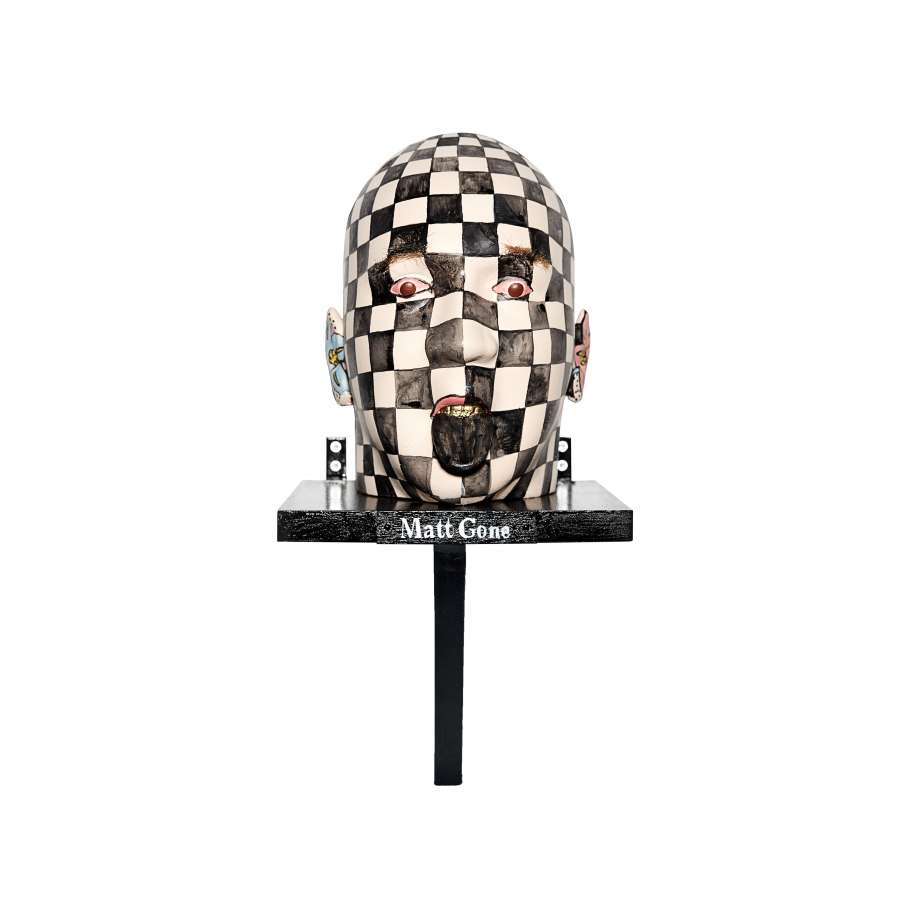

MATT GONE
Matt Gone is one of the most heavily tattooed people in the world. More than 98 per cent of his body is covered in ink, including his eyeballs and tongue. Due to medical problems, Matt Gone has many scars on his body. “I use my tattoos to hide my scars and enjoy my body.” He travels around the world with his exceptional appearance to tell people about his disease. The tattoos were applied by 140 different people. He even has tattoos in his throat, which were applied with the help of a small camera. Gone is often approached because of his tattooed body, but it rarely causes problems.“Children aren’t frightened by it, they tend to like the cubes on my face, and during passport controls, they even make extra copies of my passport. They hang them on the wall.”
Matt remained a joker despite of his difficult youth. “I have a compass tattooed on the crown of my head so I know where I am going”, he says with a blink, “and food tattooed on my hands because I’m a chef”.
The rest of his body is covered with animals and mythological figures. Matt is pretty clear about his tattoos – they are the best in the world. “My full-face tattoo is probably the most extreme tattoo on the planet. People go nuts just looking at it. Many people are jealous because it is so well thought and they wear crap. Many people do not have the balls to do this or to live with this or even the patience or sheer imagination necessary to see it through successfully. I am the only chequered person on the planet. No one has done this before so all others who may attempt it will only be copy-cats. Being original with regard to tattoo design is almost impossible.”
Matt Gone lived in New Orleans when Hurricane Katrina hit the city. He witnessed the misery it caused to many people and part of the money he earns with his eccentric appearance goes to the victims of the hurricane.
2018
Plaster, paint, mixed media
43x20.5x20.5CM
SOLD


UNKNOWN
He usually picked Dutch families with young children. His trick was to lure one of the children - often one of the younger ones - away from their parents when they were on the beach. He would then pinch the kid firmly in the arm, pressing his nails deep into the skin so that it would start crying of pain, after which he would run away, leaving the crying kid behind. The parents, alarmed, would hurry to their kid to comfort it, leaving their personal belongings unguarded. Unknown would take advantage of this moment of confusion to steal the families’ personal belongings. Besides the money, which he spent on Raki to satisfy his addiction, this activity gradually started to serve another pur- pose, as Unknown also became addicted to torturing small children. Every now and then, when he was drunk and his moral boundaries faded, he would surreptitiously hide broken glass in the sand, in areas often frequented by kids to build sand castles. He hoped they would cut themselves and that the salty seawater would aggravate the pain. This happened several times and the pleasure he felt when he saw the children cry out in pain left him craving for more. At the sound of weeping children, he would make jerky movements with his head, clench his fists and bite his lip - as if he had a wild beast inside of him, trying to break out. When the big forest fires broke out, he couldn’t take his eyes of the TV-screens in bars and shops, broadcasting a uninterrupted report of the catastrophe. The image of a woman, hysterically trying to protect her property from the sea of flames, caused a strange arousal in the Unknown. He drank another Raki, and another one, and another one, and went out.
The streets were hazy because of the smoke, and the smell of burned wood and rubber tickled his nose. The flames had surrounded the village and people were desperately trying to get away. From a distance, he saw an old woman who had difficulty walking. She couldn’t possibly survive this devastating fire. She slowly climbed a stone staircase leading to an elevated area within the village, while dragging along a filled plastic shopping bag.Unknown made jerky movements with his head and clenched his fists. He followed the old lady, keeping a distance of about ten metres. Every once and a while she would disappear into the thick smoke and he would quicken his pace to have her back in his sight. His entire body was trembling. He then proceeded to the act he’d awaited his entire life. He pushed the lady into the open doorway of a house, which was hastily abandoned by its inhabitants. She immediately fell down and from her toothless mouth came a long raw scream, which she kept re- peating. Unkown behaved like a deranged beast. As the flames came closer, he extended the old ladies agony in an indescribably atrocious manner. He tried out all the materials he could find in the abandoned house on the old body, which he considered to be his. Hammers, sickles, wood drills, hacksaws, nails and knives – he used all of them to attack his victim. Her last stretched scream could be heard far beyond the house.Then the flames took over. The fire lasted for several hours. Nothing was left of the old lady. The faith of Unkown remains unsure. He might have gotten away. In any case, nobody ever saw him again.
2018
Plaster, paint, mixed media
44x20.5x21CM
CONTACT
Isabella Bortolozzi Gallery - Berlin
info@bortolozzi.com
+49 30 26 39 76 20


FEDOR JEFTICHEW
In 1873, Europe became acquainted with a wolfman. A 55-year-old Russian man named Adrian Jeftichew, covered in hair, began to appear at various exhibitions. He was accompanied by his, equally hairy, illegitimate son, Fedor. The ‘Wild Man from the Kostroma Forest’ was billed as being the product of an affair between a bear and a Russian peasant woman, while in reality he was a man afflicted with hypertrichosis. Early in his life, Adrian fled his village and became something of a forest hermit. His taste for alcohol spiraled out of control and he was, by all accounts, a cruel drunk. Many of the visitors who visited his exhibition were disgusted by his unkempt and debauched appearance, which was in stark contrast to that of his toddler son, Fedor. The young boy, his features not yet obscured by a thick mass of hair, charmed audiences with his impish attitude and inquisitive nature. He relished speak- ing to audiences in their native languages. But the pair disappeared just as quickly as they had appeared. Nearly a decade later, a young man billed as Theodore Petroff appeared, and began a long career in sideshow. European audiences were told that hunters found young Theodore in the wild, captured him, taught him to how to be civilized and set him up to tour the world. Actually, Theodore Petroff was none other than Fedor Jeftichew. His father, after returning from his 1873 European tour, had promptly drank himself to death with his earnings. In 1884, Fedor Jeftichew met one of P. T. Barnum’s many talent agents during a tour in Liverpool. He saw great profit in joining Barnum in America and did so that same year. It was there that he was given the name Jo-Jo ‘The Dog-Faced Boy’. During his time with Bar- num, he was billed as ‘The most prodigious paragon of all prodigies secured by P. T. Barnum in over 50 years’. At his first public unveiling, he was met with audible gasps from the assembled media. His animalistic looks contrasted the neatly pressed and ornate Russian cavalry uniform he wore. Barnum answered questions and, after members of the press were affirmed that Jo-Jo did not bite, they lined up and took turns pulling his facial hair. At times Jo-Jo lived up to his namesake by growling and snapping at members of the audience. A bite from Jo-Jo would have been quite harmless, as his form of hypertrichosis robbed him of all but two teeth. At other times he was quiet and dignified. He was known to be a gentle and generous man. He was described by the New York Herald as being as playful as a puppy with his audiences and ‘the most absorbingly interesting curiosity to ever reach these shores’. He was an avid reader and spoke as many as five languages. Following his stint with Barnum, he continued to tour the world, after which he briefly returned to the United States to join up with the Barnum and Bailey’s Circus. Fedor Jeftichew caught pneumonia during a tour in Greece in 1904. He died shortly thereafter, at the age of 35, without heirs or noteworthy romances. However, when the news of his passing reached the United States, he was mourned by sideshow performers and enthusiasts throughout the country.
2018
Plaster, paint, mixed media
43x20.5x20.5CM
SOLD


FRAU EPP
2018
plaster, paint, mixed media
20.5x20.5x20.5CM
SOLD
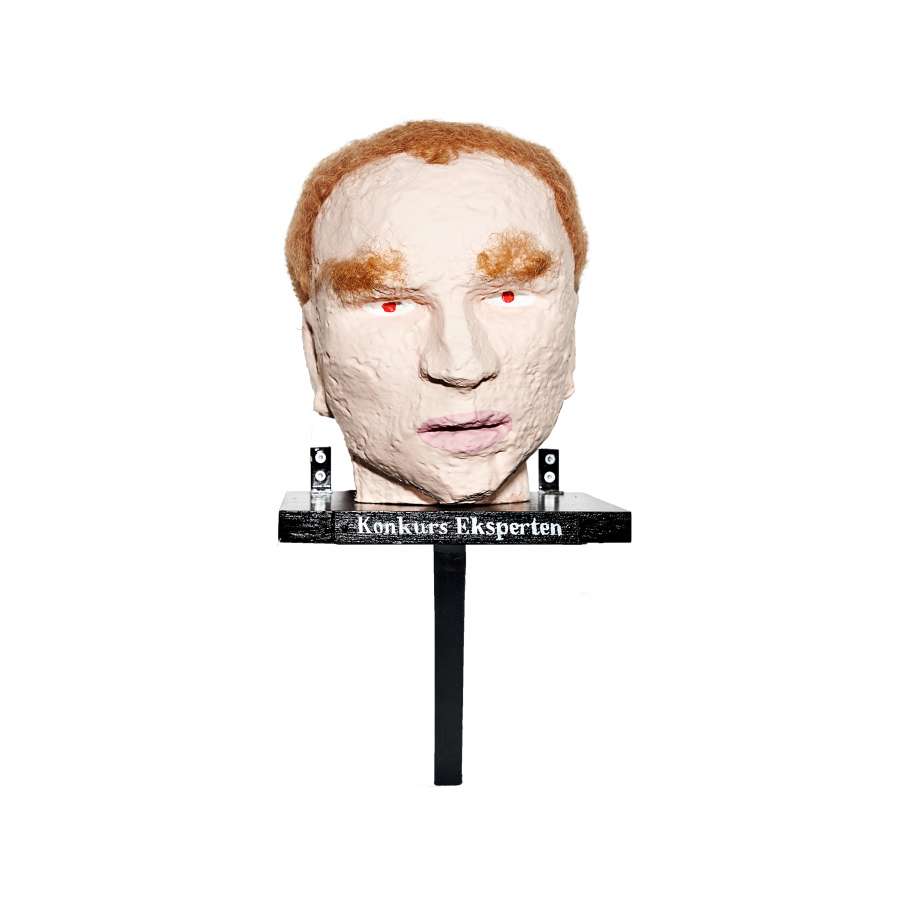

KONKURS EKSPERTEN
Konkurs Eksperten (The Bankruptcy Expert) was a great entrepreneur, a multidisciplinary artist, a workaholic and a general idea-generator. Konkurs Eksperten’s birth name was Pirelli Boas Bang. He was the lesser-known older brother of Poul Bang and Peter Boas Bang, sons of Vice-President Camillo Cavour Bang (1861-1949) and Augusta Pouline Boas (1868- 1919). In his youth, Konkurs Eksperten was propelled by his curious, restless and inquisitive nature. His actions were driven by an intense desire to achieve great things and to be serving humanity, but his high ideals and creativity were too often wasted on personal matters and moods, instead of being translated into constructive actions. His brothers often told him he had a lack of understanding and that he wasn't good enough. Konkurs Eksperten had a strong desire to be his own boss, yet he had great difficulty to stabilize his life, and to settle down and be more ‘cumulative’. His cynical and caustic personality would subject the people around him to outbursts of anger and waves of self-pity. His domestic life was particularly prone to this. Konkurs Eksperten suffered mood swings that would make his mind-set shift from optimistic into pessimistic in nanoseconds, and he would often lose himself in self-indulgent habits, such as smoking, drinking and emotional outbursts. In spite of his sociopathic behaviour, Konkurs Eksperten developed a fine sensibility and an appreciation for the finer things in life, such as visual art, folk music, and storytelling. He was also capable of making a good first impression by displaying a friendly and debonair personality. Growing older, Konkurs Eksperten learned to tame his wild heart and to somehow survive in the ethereal world of art and antiquities.
2018
Plaster, paint, mixed media
46x20.5x22CM
CONTACT
Gallery Micheline Szwajcer - Antwerp
contact@gms.be
+32 3 237 11 27


Helmut Salomon
Helmut Salomon is the perfect example of a Sadist. He is an extremely calculating and meticulous businessman, which allows him to attain a high social status. He has a charming appearance and eternal smile, paired with an air of self-confidence. He owns a large house in the vicinity of Munich, which is packed with art. His villa’s garage houses an impressive collection of oldtimers. He spends his days off walking around in a white bathrobe, listening to classical music and admiring his art collection, his English garden and his oldtimers. He does not tolerate any intruders on his property. Weeds and insects in the garden can trigger outbursts of anger of which the consequences can be quite extensive. There is a sweeping list of domestic staff that was fired after making a minor mistake. These dismissals always follow the same pattern. Helmut Salomon discovers a small detail, such as a bottle of milk in the fridge that has passed its expiration date, calls the housekeeper that is responsible for it, and subjects her to an in-depth interrogation without mentioning its purpose. In case of the expired milk, he will start questioning her about her family situation, her kids, her faith, and her general attitude to life. He will then confront her with her mistake and insult her. In his cursing rant he blames her for being a poisoner, a negligent mother, and a murderer. The poor woman will burst into tears and apologise repeatedly. At this point Salomon will compose himself, put his hand on his victim’s shoulder and soothe her. Surely she would not want him to lose control over everything he has built, she cannot be that bad a person. Once the woman is somewhat recovered from the shock and agrees with everything he said, he fires her any- way. He will hand her a glass of water with his eternal smile and offer her an extra week’s salary as a sign of goodwill, provided she agrees to see a psychologist. Once the woman has walked out the door, he immediately calls the employment agency of a good friend and asks for a new employee, while casually dropping that the woman he just fired is to be avoided at all costs as a domestic help, and in consequence, should be removed from every list in all of the employment agencies, so she won’t be able to find another job. The suffering of the domestic help, however, is nothing compared to the cruel faith of the women that engage in a romantic relationship with Helmut Salomon. His charisma and confidence are like a magnet, attracting women who are going through a difficult period or suffer from a borderline personality disorder. Sly like a fox, Helmut seduces them, offering them security and feigned love. Once he’s assured himself he has them in his power, a long sadistic game kicks off, which can only end in total submission and destruction. He locks them in his villa and creates a ‘safe home’, after which he gradually destroys their personality in a gruesomely slow process. When he has to go on a business trip for a long period of time, he wants to ease his wife’s loneliness by buying her a kitten, which he affectionately offers her as a gift. Once the wife gets attached to her small companion, he kills the little animal. He then confesses his crime with tears in his eyes and begs for his wife’s forgiveness. After all, he had been under the impression that the animal jeopardised their relationship and that she no longer loved him. This brief instant, during which he puts his wife in a position of power, is merely a part of Helmut Salomon’s dirty strategy - a strategy in which he pulls the strings. When his wife forgives him for killing her cat, he asks her to accompany him on a business trip to an exotic country so he can make it up to her. He then uses this trip to continuously belittle and humiliate her. The woman, weak and psychologically beaten by the eternally smiling Helmut, slowly enters the last stage of her life. She is either driven towards insanity or suicide. At this point Salomon considers his task to be accomplished and starts to wallow in self-pity. He cries at his wife’s grave, or when he leaves her at the psychiatric institution. “Nobody could have done anything to help her” - he sobs. Then his smile returns and he scans the area with piercing eyes, looking for his next victim.
2018
Plaster, paint, mixed media
46x20.5x22CM
CONTACT
Gallery Essex Street - New York
info@essexstreet.biz
+1 917-675-6681


VAN DER MAELEN
Van Der Maelen lived on the first floor of an apartment block on the Bist in Wilrijk close to Antwerp. He was a computer expert and had a sexual relationship with the inventor of Excel. During the years he helped to develop Excel 95 (v7.0) and later Excel 2010 (v14.0). The relationship stopped because Van der Maelen became a vegan. He still had a working relationship with the inventor of Excel. Both were working on a new version with 10485764467932 rows, and 1638476977720 columns. It will come out in the winter of 2019. Once he had a hamster that he taught how to speak. Van Der Maelen disappeared all of a sudden. He was missing from work. The shutters of his apartment on the Bist were closed. When the police broke in a few months later they found him in the kitchen. He was sitting at the table with a smile on his face. It took a few minutes for the officers to realize he was dead. His body had not decomposed. The computer was still on.
2018
plaster, paint, mixed media
42.5x20.5x20.5CM
CONTACT
Gallery Micheline Szwajcer - Antwerp
contact@gms.be
+32 3 237 11 27
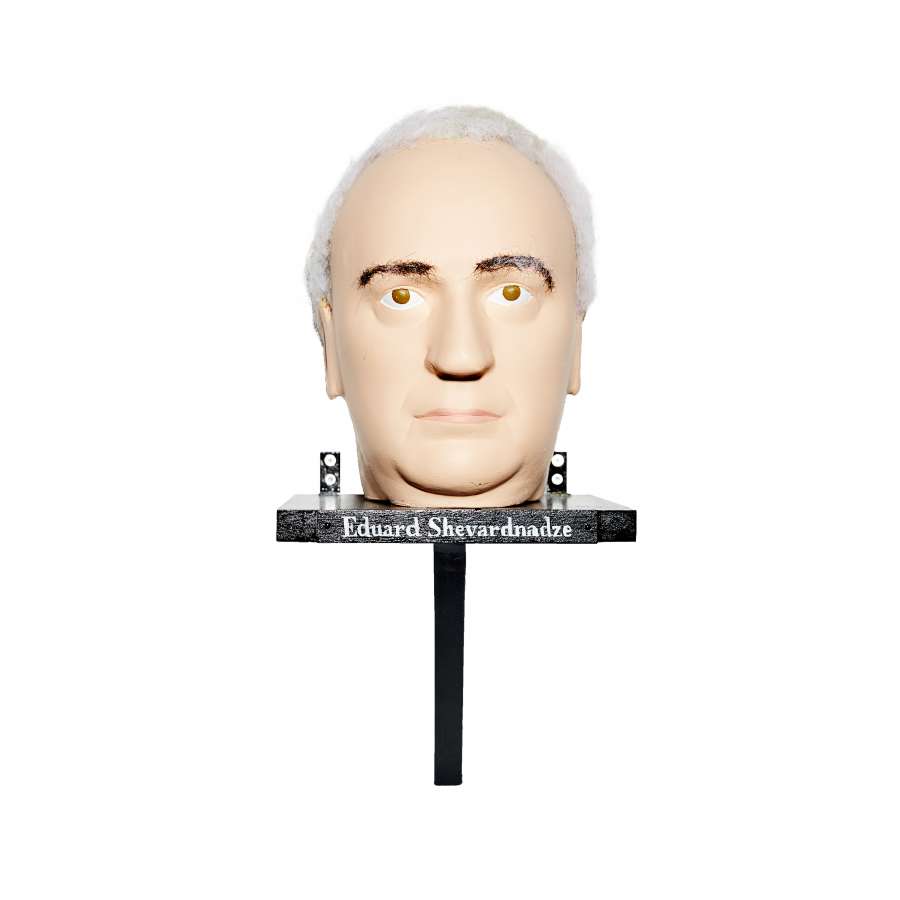

EDUARD SHEVARDNAZDE
Shevardnadze was born in Mamati, a small town in Georgia, not far from the Black Sea.
Being a child of the revolution, Shevardnadze had great confidence in the communist ideology, and during his entire adult life he fulfilled both public and political functions within the Soviet Union’s communist system. Yet his career was marked by inner conflicts.
In 1950, he met Nanuli Tsagareishvili and fell in love with her. Nanuli was a journalist and activist whose father had been executed by Stalin for being ‘an enemy of the state’. Her relationship with Shevardnadze was a hindrance to his career within the Communist Party and Nanuli repeatedly begged him to end their relationship. Shevardnadze, nevertheless, chose to risk everything and married her in 1951. A new wind was blowing in the Soviet Union after Stalin’s waning power and death in 1953, which fast-tracked Shevardnadze’s career in the Communist Party. He became nationally renowned for his fierce battle against corruption among the soviet officials. In 1959, he became a member of the Supreme Soviet of the Georgian SSR, and in 1965 he was promoted to Minister of Public Order. He was Minister of Internal Affairs of the USSR between 1968 and 1972, after which he became First Secretary of the Communist Party, one of the leading positions in the Soviet Union. During the government of Gorbachev in the 80’s, he became Minister of Foreign Affairs and gained international recognition for his role in the Germany reunification. He truly made his mark on the international political scene. The Collapse of the Soviet Union, however, engendered a conflict with Gorbachev, in which Shevardnadze would ultimately lose out. In his final speech as Minister of Foreign Affairs he warned the world for a new dictatorship in Russia by the end of the 20th Century. He returned to Georgia with Nanuli, which in the meanwhile had become an independent state, and was elected president there in 1995. Numerous border conflicts with Russia and the Chechen rebels would, however, cause political instability and economic disorder. Shevardnadze no longer had the power to take up his role as leader, and in 2003 the people started to revolt, which resulted in an angry crowd surrounding the presidential palace. The army was ready to intervene, but it was Nanuli who eventually persuaded her husband to resign, and to once again choose her, just as he had in back in 1951. The riots ended without bloodshed and would go down in history as The Revolution of Roses. After his resignation, Shevardnadze was officially invited to settle in Germany, where he remained very popular thanks to his role in the Germany reunification. The former president expressed his gratitude for the invitation, but replied that he was very fond of Georgia and would not leave the country. Nanuli died in 2004. Eduard Shevardnadze died in 2013.
2018
plaster, paint, mixed media
43.0x20.5x20.5CM
CONTACT
Gallery Essex Street - New York
info@essexstreet.biz
+1 917-675-6681


Filip De Winter
Dewinter studied under the Xaverian Brothers in Bruges. As a student, he would regularly push the boundaries of acceptability and get into mischief. He would, for instance, shoot spitballs at the fathers while they were teaching and was regularly made to stand in the corner for writing obscenities on the blackboard before class. As he grew older, he would gradually start to toe the line and soon turned into an exemplary student, much to the delight of the Fathers and the Prefect. To them, Dewinter was a youngster they had successfully moulded into an exemplary human being - an eloquent and driven individual, bound for success. When he turned 16, Filip Dewinter founded the "Vlaamse Studenten Actiegroep" or “Flemish Student Action Group” (VSA), a militant youth movement that was fighting for an independent Flanders. The group was mainly joined by children of Nazi collaborators. The VSA members would essentialy attend Flemish Nationalist demonstrations during which they would wave flags and march with drums. After university, Dewinter entered politics. He became one of the founders of the Vlaams Blok, a radical right-wing populist party that mainly capitalised on the dissatisfaction of the common man. It was partly thanks to his eloquence and his convincing speeches that the Vlaams Blok became an important political party. However, his rampant boldness also took its toll. He once started a speech for the Flemish Nationalist collaborators with the words "Meine Ehre heißt Treue"which, during WWII, was the motto of the SS.
His party reacted with dismay, as it was precisely trying to rid itself from its Fascist side in order to grow into a fully fetched political movement.
Dewinter was sidelined and nowadays mainly occupies himself with organising barbeques for the like-minded in name of the party.
2018
plaster, paint, mixed media
43.5x20.5x20.5CM
CONTACT
Gallery Micheline Szwajcer - Antwerp
contact@gms.be
+32 3 237 11 27
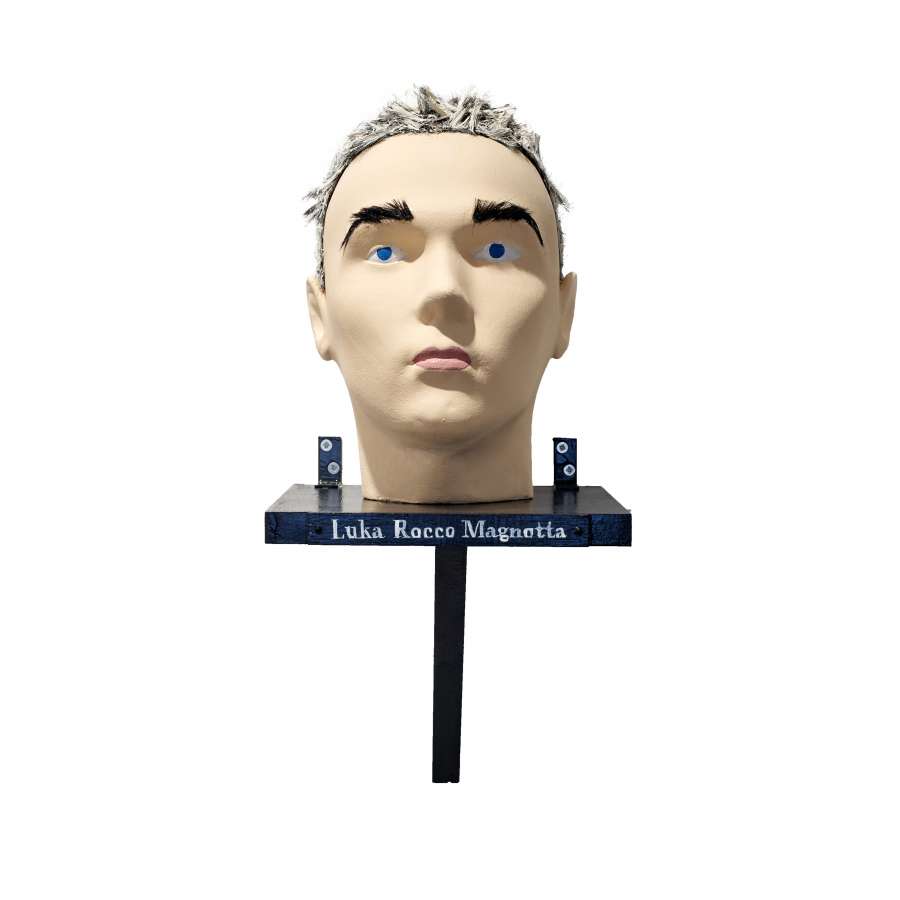

Luka rocco magnotta
2018
Plaster, paint, mixed media
43x20x20CM
SOLD
GAPEX
SHOP
Rue Ravenstein 32 Ravensteinstraat, 1000 Brussels – Belgium, VAT No. BE 0635.955.655.
Copyright of the content of this Website (including its appearance, structure and presentation) is owned by SNC Gapex VOF. Except as permitted by the copyright law applicable to you, you may not reproduce or communicate any of the content on this Website, without the permission of SNC Gapex VOF.
Rue Ravenstein 32 Ravensteinstraat, 1000 Brussels – Belgium, VAT No. BE 0635.955.655.
Copyright of the content of this Website (including its appearance, structure and presentation) is owned by SNC Gapex VOF. Except as permitted by the copyright law applicable to you, you may not reproduce or communicate any of the content on this Website, without the permission of SNC Gapex VOF.